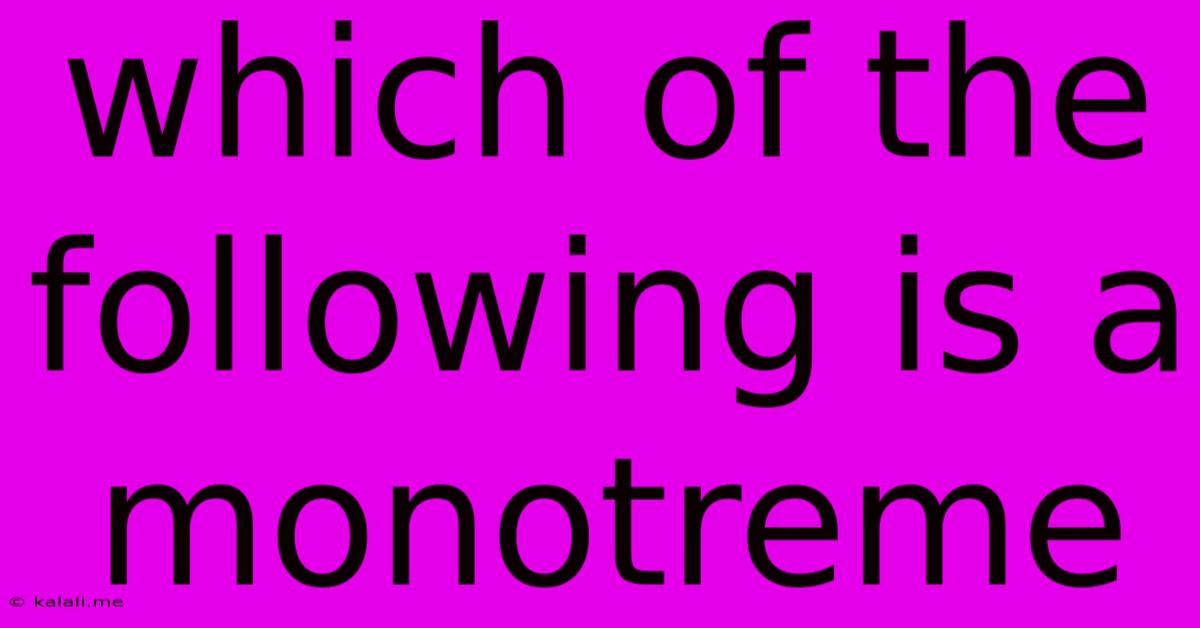Which Of The Following Is A Monotreme
Kalali
Jun 15, 2025 · 2 min read

Table of Contents
Which of the Following is a Monotreme? Understanding Unique Mammals
This article will explore the fascinating world of monotremes, answering the question: "Which of the following is a monotreme?" We'll delve into the characteristics that define monotremes, differentiating them from other mammals, and provide examples to solidify your understanding. This will also cover key characteristics and evolutionary significance, making it a comprehensive guide for anyone curious about these unique creatures.
What are Monotremes?
Monotremes are a group of mammals that lay eggs instead of giving birth to live young. This unique reproductive strategy sets them apart from other mammals, which are classified as either marsupials (pouched mammals) or placentals (mammals that develop inside a placenta). They represent a crucial branch in mammalian evolution, showcasing an ancient lineage. This characteristic, along with other distinguishing features, makes them a captivating subject of study in zoology and evolutionary biology.
Key Characteristics of Monotremes:
- Laying Eggs (Oviparity): This is the most defining characteristic of monotremes. They lay leathery-shelled eggs, which are incubated until hatching.
- Cloaca: Unlike other mammals with separate openings for their urinary, digestive, and reproductive tracts, monotremes possess a cloaca – a single opening for all three.
- Electroreception: Some monotremes, like the echidnas, possess electroreception, the ability to detect electrical fields generated by prey. This is a highly specialized sense, vital for their foraging habits.
- Low Metabolic Rate: Compared to other mammals, monotremes have a relatively low metabolic rate.
- Milk Production: Although they lay eggs, female monotremes produce milk to nourish their young. However, they don't have nipples; the milk is secreted onto the skin, allowing the young to lap it up.
Examples of Monotremes:
There are only five extant species of monotremes, all found in Australia and New Guinea:
- Echidnas (Tachyglossidae): There are four species of echidnas, characterized by their spiny bodies and long snouts used for foraging for insects. They are also known for their remarkable ability to curl into a ball for protection.
- Platypuses (Ornithorhynchus anatinus): The platypus is arguably the most iconic monotreme, known for its unique combination of features – a duck-like bill, otter-like body, and webbed feet.
Differentiating Monotremes from Other Mammals:
Understanding the characteristics above helps differentiate monotremes from marsupials and placentals. Marsupials give birth to relatively undeveloped young, which continue to develop in a pouch. Placentals, on the other hand, nurture their young inside the mother's body via a placenta until they are fully developed before birth. Monotremes, with their egg-laying and other unique characteristics, stand distinctly apart.
In Conclusion:
To answer the question directly: Any of the following options that lists an echidna or a platypus is correct. These are the only two genera of extant monotremes. Understanding the unique characteristics of monotremes – egg-laying, cloaca, electroreception, and milk production without nipples – allows for clear identification and appreciation of their significance in mammalian evolution. Their existence offers a crucial link to the past, illuminating the incredible diversity and adaptability of mammals.
Latest Posts
Latest Posts
-
A Modulator Demodulator Is Better Known As A What
Jun 15, 2025
-
Which Of The Following Pollutants Causes Artificial Eutrophication
Jun 15, 2025
-
A Car Travels S Kilometers In 6 Hours
Jun 15, 2025
-
Lcm Of 3 6 And 9
Jun 15, 2025
-
What Is The Opposite Of Obedient
Jun 15, 2025
Related Post
Thank you for visiting our website which covers about Which Of The Following Is A Monotreme . We hope the information provided has been useful to you. Feel free to contact us if you have any questions or need further assistance. See you next time and don't miss to bookmark.